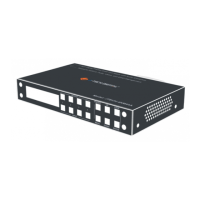
Do you have a question about the J-Tech Digital JTD-669 and is the answer not in the manual?
| Brand | J-Tech Digital |
|---|---|
| Model | JTD-669 |
| Category | Switch |
| Language | English |
Product contains sensitive components vulnerable to electrical spikes, surges, and lightning strikes.
Highlights HDMI 2.0, HDCP compliance, HDR support, and multiple control methods.
Enumerates all items provided with the JTECH-4KM44A matrix switcher.
Details operating parameters, resolution, bandwidth, ports, and physical dimensions.
Describes buttons like INPUT, OUTPUT, PRESET, MENU, UP, DOWN, ENTER, LOCK, and the LCD screen.
Location for receiving infrared signals from the remote control.
Identifies HDMI Input/Output ports and audio output ports (Analog, S/PDIF).
Details RS232, IR-Ext, Ethernet IP Control, and DC Power ports.
Step-by-step guide for connecting sources, displays, power, and optional network/serial cables.
Final step to power on the matrix, sources, and displays.
Visual representation of how sources, displays, and controls connect to the matrix.
Labels and functions of buttons on the remote control.
Instructions for using the remote for power, routing, muting, and presets.
Explanation of the 4x4 matrix capability for routing inputs to outputs.
Practical examples demonstrating how to route specific inputs to desired outputs.
Guide to navigating the main menu to reach Video > Switching and Video > On/Off.
Step-by-step instructions for selecting output ports and desired input signals.
Steps to enable or disable individual output ports or all output ports via the menu.
How to control HDMI output audio, enabling or disabling it per output.
How to enable or disable the de-embedding of audio signals to analog/digital outputs.
Detailed steps for the "Line Out" function to control HDMI audio.
Detailed steps for the "De-Embed" function to manage audio extraction.
Explains User EDID, Built-in EDID, and Copy EDID functions.
Lists available default EDID profiles with associated resolution, audio, and HDR data.
Procedure to select and apply a specific EDID profile to an HDMI input port.
Shows the menu for selecting input ports and available EDID profiles.
Instructions for saving, calling, and clearing up to 8 presets.
Accessing Call Scene, Save Scene, and Clear Scene options.
How to adjust the serial port baud rate.
Accessing settings for DHCP, rebooting, and factory reset procedures.
Step-by-step guide to select and apply a new baud rate.
Steps to turn on DHCP for automatic IP address allocation.
Notes on static IP configuration when DHCP is disabled.
How to confirm and start the device reboot sequence.
Resets most settings except network and presets.
Resets all device settings to factory defaults.
Step-by-step guide to perform a factory reset.
How to view system details like company name and firmware version.
How to check network details such as IP address and MAC address.
Shows system version, product type, and company name.
Shows IP, Mask, Gateway, and MAC address information.
Steps to configure COM port settings and connect the software.
Guide on composing and sending commands via RS232.
Explains the required format for RS232 commands, including command heads and parameters.
How to set the PC's IP address, subnet mask, and gateway for web GUI access.
Details on configuring TCP/IPv4 properties for network communication.
Steps to log into the web interface with default credentials.
Managing output ports, inputs, and presets through the web GUI.
How to rename input, output, or preset ports via the web interface.
Using the web interface to route inputs to outputs and manage presets.
Interface for renaming ports within the web control panel.
Enabling or disabling HDMI output audio for each output port.
Enabling or disabling the de-embedding of audio signals.
Viewing EDID details like resolution, audio format, and HDR.
Steps to create and save custom EDID profiles to user slots.
Procedures for applying default or user-defined EDID profiles to HDMI inputs.
Interface to map EDID profiles to specific input ports.
Dedicated page for creating and assigning user-defined EDID profiles.
Setting a static IP, subnet mask, and gateway.
Enabling DHCP for automatic network configuration.
Displays Mac Address, IP Address, Net Mask, and Gateway.
Shows whether DHCP is enabled or disabled.
Rebooting the device without clearing user parameters.
Accessing partial or full factory reset options.
Changing the username and password for device access.
Steps to upgrade MCU firmware using UART ISP software via USB.
Steps to upgrade web application firmware via USB.
Important notes on disconnecting devices and avoiding interruption during upgrades.
Procedure for upgrading web interface firmware using UART ISP software.
Detailed upgrade steps and crucial warnings for the process.
Instructions for cleaning the unit with a soft, dry cloth.
Conditions requiring service, replacement parts, and safety checks.
Details warranty period, repair/replace options, and required proof of purchase.
How to pack and send the unit for warranty service.
Lists damages and conditions not covered by the warranty.
How to gain an additional 6 months of warranty by registering the product.
Rules and deadlines for claiming the extended warranty period.